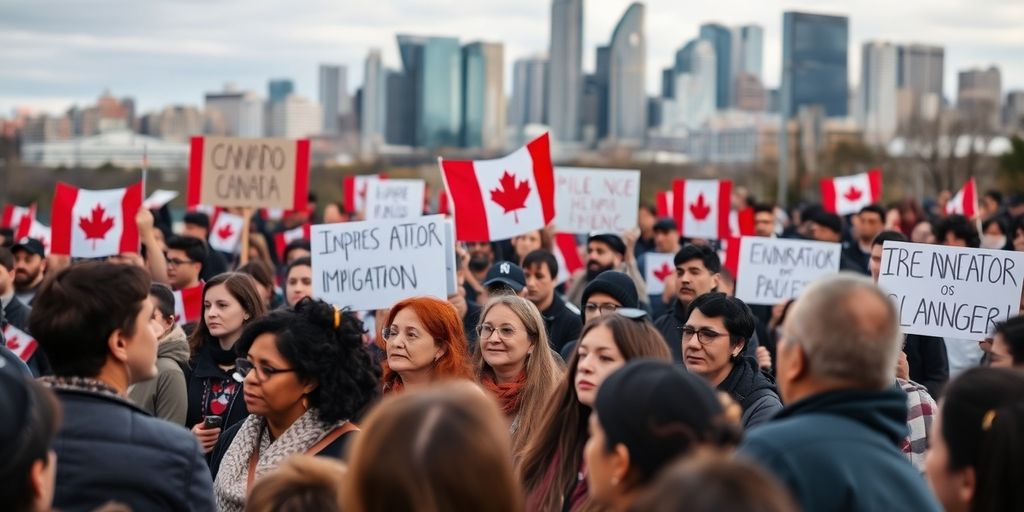In recent months, Canada has seen a noticeable shift in attitudes towards immigration, sparking debates about its future policies. Once celebrated as a welcoming haven for newcomers, the country is now grappling with rising anti-immigrant sentiment, particularly directed at Nigerians and other groups. This article explores the roots of this backlash, the economic concerns fueling it, and the potential implications for Canada’s immigration landscape as we approach 2025.
Key Takeaways
- Canada’s immigration policies are facing increasing scrutiny as public opinion shifts against high immigration levels.
- Economic pressures, including housing shortages and healthcare strains, are major factors contributing to anti-immigrant sentiment.
- Political leaders, including Prime Minister Trudeau, are adjusting immigration targets in response to public concerns.
- Rising hate crimes and social division are significant consequences of the current anti-immigrant climate in Canada.
- Local attitudes toward immigration vary widely across provinces, reflecting diverse community perspectives.
Understanding Canada’s Anti-Immigrant Backlash
Historical Context of Immigration in Canada
Canada has always prided itself on being a welcoming nation, built by immigrants from around the globe. "Study, work and stay” was the slogan of a government campaign to lure international students. However, this narrative is now being challenged. Historically, immigration policies have shifted based on economic needs and social attitudes. Understanding these past trends is essential to grasping the current backlash. Canada long sold itself as a beacon for immigrants, who were widely viewed as key to economic growth in a vast nation with a small and rapidly aging workforce.
Recent Shifts in Public Opinion
For the first time in a quarter-century, a majority of Canadians are expressing concerns about the level of immigration. This represents a significant change from the traditionally positive views held towards newcomers. Several factors contribute to this shift, including economic anxieties and perceived strains on public services. Just five years after a 2019 Gallup study named Canada the most accepting country for immigrants, polls today show that views have shifted dramatically, with an increasing number of Canadians expressing concern about the number of newcomers, the government’s ability to provide for them and how well immigrants are integrating into society.
The Role of Political Rhetoric
Political discourse plays a crucial role in shaping public perception. The rise of far-right figures and the adoption of anti-immigrant rhetoric by mainstream politicians have fueled the backlash. Migrant advocates say public opinion has been shaped by far-right firebrands like Bernier, who has said immigrants represent a threat to “our values and way of life,” and more mainstream opposition leaders, such as Conservative Party leader Pierre Poilievre, who has described the country’s immigration system as “out of control” and “chaos.”
It’s important to recognize that the current anti-immigrant sentiment is not happening in a vacuum. It’s influenced by a complex interplay of economic factors, historical context, and political narratives. Understanding these elements is key to addressing the issue effectively.
The Economic Argument Against High Immigration
Housing Crisis and Rising Costs
The housing market in Canada has been, to put it mildly, a rollercoaster. I’ve watched as prices have climbed, making homeownership feel like a distant dream for many, including younger members of my own family. The rapid increase in immigration, while bringing many benefits, has undeniably added pressure to an already strained housing supply. It’s not the only factor, of course; interest rates, zoning laws, and construction rates all play a role. But the increased demand from a growing population certainly isn’t helping. We need to address the root causes of the housing crisis, and simply blaming immigrants is not the answer. The average price of a home has soared nearly 50% since 2018.
Strain on Healthcare Services
Our healthcare system is something I deeply value, but I can’t deny that it’s showing signs of wear and tear. Wait times are getting longer, and finding a family doctor feels like winning the lottery. Is immigration solely to blame? No. An aging population and chronic underfunding are significant contributors. However, a larger population inevitably places a greater demand on healthcare resources. We need to invest in our healthcare infrastructure to ensure that everyone, including newcomers, has access to the care they need. It’s about planning and resource allocation, not about closing our doors.
Job Market Concerns
I understand the anxiety some people feel about immigrants taking jobs. I’ve heard the concerns firsthand from friends and neighbors who worry about their own job security. The reality, however, is more nuanced. While there may be short-term adjustments and competition in certain sectors, immigrants also create jobs by starting businesses, filling labor shortages, and driving economic growth.
It’s crucial to remember that immigrants contribute to the economy in many ways beyond just filling jobs. They bring new skills, ideas, and entrepreneurial spirit. Scapegoating them for economic woes is not only unfair but also counterproductive.
Here are some ways immigrants contribute to the job market:
- Filling labor shortages in key sectors like healthcare and technology.
- Starting businesses and creating jobs for Canadians.
- Bringing diverse skills and perspectives that drive innovation.
It’s about ensuring fair wages and working conditions for everyone, regardless of their background. We need to focus on creating an inclusive economy where everyone has the opportunity to thrive.
Political Responses to Immigration Concerns
Trudeau’s New Immigration Plan
As someone observing the political landscape, I’ve noticed a significant shift in the Trudeau government’s approach to immigration. Under fire for previously admitting record numbers of migrants, the government has recently made an abrupt about-face. The new plan aims to slash the number of permanent residents by nearly 20% next year, and significantly reduce the intake of temporary workers and international students. This is a clear attempt to regain public trust and address concerns about the strain on resources. It’s a calculated move, but whether it will resonate with voters remains to be seen. The government is also planning to beef up security along the U.S. border.
Conservative Party’s Stance
The Conservative Party, under its current leadership, has adopted a much more critical stance on immigration. They’ve described the current system as "out of control" and "chaos," echoing sentiments that resonate with a growing segment of the population. This rhetoric has proven effective in galvanizing support, with polls suggesting they are poised to win a majority in the next election. Their approach is markedly different from the Liberal Party’s, focusing on stricter border controls and a more selective immigration policy. It seems they are tapping into the economic anxieties of many Canadians.
Far-Right Influence on Policy
While mainstream parties are adjusting their stances, the influence of far-right groups on the immigration debate cannot be ignored. These groups often promote anti-immigrant narratives, framing immigrants as a threat to Canadian values and way of life. Although they may not hold significant political power directly, their rhetoric can seep into the mainstream, shaping public discourse and influencing policy indirectly. It’s a worrying trend that needs careful monitoring. The emergence of the People’s Party of Canada in 2018 kept the topic in the national conversation in the lead-up to the 2019 federal election.
It’s important to remember that immigration policy is not just about numbers; it’s about people’s lives, their hopes, and their contributions to our society. We need to have a balanced and compassionate approach that addresses legitimate concerns while upholding our values of inclusivity and diversity.
The Impact of Anti-Immigrant Sentiment
Rising Hate Crimes and Xenophobia
As anti-immigrant sentiment rises, I’ve noticed a disturbing trend: an increase in hate crimes and open displays of xenophobia. It’s disheartening to see how quickly negativity can escalate. Reports indicate a doubling of hate crimes between 2019 and 2023, which is a stark reminder of the real-world consequences of harmful rhetoric. It’s not just about numbers; it’s about the fear and insecurity it creates within immigrant communities.
Social Division and Identity Crisis
I believe that the current anti-immigrant sentiment is causing a significant social division. Canada has long prided itself on being a welcoming and multicultural nation, but this reputation is being challenged. The rise in negativity has triggered what some are calling an identity crisis, forcing us to confront uncomfortable truths about our society. It’s as if the very fabric of our national identity is being questioned, and we’re struggling to reconcile our ideals with the current reality.
Effects on Current Immigrants
The impact on current immigrants is profound. The uncertainty surrounding immigration policies and the rise in hostility create an environment of anxiety and fear. Many immigrants who came here with hopes of building a new life are now questioning their decision. The emotional toll is immense, with reports of increased stress, depression, and even suicides among international students. It’s a heartbreaking situation, and I feel we need to do more to support those who have already made Canada their home. The economic woes are being unfairly blamed on them.
It’s crucial to remember that behind every statistic, there’s a human story. These are individuals and families who have contributed to our society, enriched our culture, and deserve to be treated with dignity and respect. We must actively combat the spread of misinformation and promote understanding and empathy towards immigrants.
Local Perspectives on Immigration
Diverse Attitudes Across Provinces
As I examine the immigration landscape across Canada, it’s clear that opinions vary significantly from province to province. For example, Quebec has expressed concerns about maintaining its cultural identity, particularly the French language, in the face of increasing immigration. This has led to the province setting its own immigration limits, often lower than what would be proportional to its population. Other provinces, like those in the Prairies, might have different economic needs influencing their views on immigration. It’s not a one-size-fits-all situation, and understanding these regional nuances is essential.
Community Reactions in Urban Areas
Urban centers, like Toronto and Vancouver, which have historically welcomed large numbers of immigrants, are now experiencing a mix of reactions. While many residents celebrate the multiculturalism these newcomers bring, others are voicing concerns about the rising cost of living, especially housing. I’ve heard stories of long-time residents feeling like they’re being priced out of their own neighborhoods. It’s a complex issue with no easy answers. The rapid pace of change can be unsettling, even in communities that pride themselves on being inclusive.
Voices from Immigrant Communities
It’s also important to consider the perspectives within immigrant communities themselves. I’ve noticed that even among newcomers, there’s a range of opinions on current immigration levels. Some feel that Canada’s support systems are becoming strained, making it harder for new arrivals to succeed. Others worry about the rise of anti-immigrant sentiment and the impact it has on their sense of belonging. Hearing these voices is crucial for a balanced understanding of the situation.
The experiences of immigrants are not monolithic. Some find success and integration relatively easy, while others face significant challenges related to language barriers, employment opportunities, and social isolation. These individual stories highlight the need for tailored support and a more nuanced approach to immigration policy.
Here’s a simple breakdown of potential challenges:
- Language barriers
- Employment scarcity
- Social isolation
The Role of Media in Shaping Perceptions
Coverage of Immigration Issues
As someone who follows current events closely, I’ve noticed how the media presents immigration stories can really change what people think. It’s not just about what they report, but how they report it. Are they focusing on the challenges, or are they highlighting the contributions immigrants make? It makes a big difference. For example, a news segment about government resources available to immigrants might paint a different picture than one focusing solely on overcrowded shelters.
Influence of Social Media
Social media is a beast of its own. It’s where opinions spread like wildfire, and often, those opinions aren’t based on facts. I’ve seen so many misleading posts about immigration, and it’s scary how easily they can sway public opinion. It’s like everyone’s an expert, sharing their two cents without really understanding the complexities. The echo chambers on these platforms reinforce existing biases, making it harder to have a reasonable discussion.
Public Figures and Their Impact
What public figures say about immigration matters a lot. When politicians or celebrities weigh in, people listen. If they use divisive language, it can fuel anti-immigrant sentiment. On the other hand, if they speak out in support of immigrants, it can help to counter the negativity. It’s a huge responsibility, and I wish more of them would take it seriously.
It’s easy to blame the media, but we all play a role in shaping the narrative around immigration. What we share, what we believe, and how we talk about it all contributes to the bigger picture. It’s up to each of us to be more informed and more thoughtful in our discussions.
Here’s a quick look at how different media outlets covered a recent immigration policy change:
| Media Outlet | Tone | Focus |
|---|---|---|
| Newspaper A | Neutral | Policy details, economic impact |
| TV Channel B | Negative | Potential strain on social services |
| Online Blog C | Positive | Stories of successful immigrants |
It’s clear that the same event can be framed in very different ways, depending on the outlet’s agenda.
Comparative Analysis with Other Countries
Immigration Policies in the U.S. and Europe
When we look at the U.S. and Europe, it’s clear their approaches to immigration differ significantly from Canada’s. The U.S., for instance, grapples with a complex system often influenced by political debates, leading to inconsistent policies. Europe, on the other hand, faces its own set of challenges, with varying policies across different nations and the rise of anti-immigrant sentiment impacting decision-making. It’s interesting to see how each region balances economic needs with social concerns. Canada’s focus on economic immigration sets it apart.
Lessons from Global Anti-Immigrant Movements
Looking at global anti-immigrant movements, there are some pretty clear patterns. Often, these movements are fueled by economic anxieties, cultural preservation concerns, and sometimes, just plain misinformation. These movements tend to gain traction when governments fail to address the root causes of public discontent or when mainstream media amplifies divisive rhetoric. Learning from these global trends is essential for Canada to avoid similar pitfalls. We need to understand what triggers these movements and how to counter them effectively.
It’s important to remember that anti-immigrant sentiment often stems from a place of fear and uncertainty. Addressing these underlying issues through open dialogue and education is key to fostering a more inclusive society.
Canada’s Unique Position
Canada occupies a unique position on the global stage when it comes to immigration. Unlike many European countries facing aging populations and declining birth rates, Canada has actively embraced immigration as a tool for economic growth and social development. While countries like Australia and New Zealand have similar points-based systems, Canada’s multiculturalism policy and emphasis on immigrant integration distinguish it. This approach, however, isn’t without its challenges, as evidenced by the current debates surrounding housing affordability and strain on social services. It’s a balancing act, and whether Trudeau will close the door in 2025 remains to be seen.
Future of Immigration in Canada
Predictions for 2025 and Beyond
As we move closer to 2025, the future of immigration in Canada is a topic filled with both anticipation and uncertainty. The government’s target of welcoming 500,000 new immigrants annually is ambitious, but recent shifts in public sentiment suggest that this goal may face considerable challenges. I believe that the success of these immigration plans hinges on addressing the concerns of Canadians regarding housing, healthcare, and job availability. It’s a balancing act between economic needs and social well-being. The recent implementation of category-based Express Entry draws is a step in the right direction, but more comprehensive strategies are needed to ensure a smooth integration process for newcomers.
Potential Policy Changes
I anticipate that we’ll see some adjustments to immigration policies in the coming years. With increasing public anxiety, the government might be compelled to tighten certain criteria or prioritize specific skill sets that are in high demand. Economic immigration will likely remain a key focus, but there could be increased scrutiny on family reunification programs and refugee resettlement initiatives. It’s also possible that we’ll see more regional variations in immigration policies, with provinces having greater autonomy in selecting immigrants based on their specific needs. These changes could be subtle or significant, but they will undoubtedly shape the landscape of immigration in Canada.
Public Sentiment Trends
Public sentiment is a critical factor that will influence the future of immigration in Canada. Recent polls indicate a growing unease about the current levels of immigration, with many Canadians expressing concerns about the strain on resources and infrastructure. This shift in public opinion could lead to increased political pressure on the government to adopt a more cautious approach to immigration. It’s essential to monitor these trends closely and engage in open and honest conversations about the benefits and challenges of immigration. Only through dialogue and understanding can we hope to create a more inclusive and welcoming society for all.
It’s important to remember that immigration is not just about numbers; it’s about people. Each immigrant brings unique skills, experiences, and perspectives that can enrich our society and contribute to our economy. We must strive to create a system that is fair, efficient, and responsive to the needs of both newcomers and long-time residents.
Advocacy and Support for Immigrants
Organizations Fighting for Immigrant Rights
As anti-immigrant sentiment rises, the role of organizations dedicated to protecting and advocating for immigrants becomes even more vital. These groups work tirelessly on multiple fronts, from providing legal aid to lobbying for policy changes. They are the front line of defense against discriminatory practices and policies. I’ve seen firsthand how these organizations help newcomers understand their rights and navigate the complex immigration system. It’s not just about legal battles; it’s about ensuring that immigrants are treated with dignity and respect.
- Legal Aid Services: Offering free or low-cost legal representation.
- Policy Advocacy: Lobbying for fair and just immigration laws.
- Community Outreach: Educating immigrants about their rights and available resources.
Community Support Initiatives
Beyond formal organizations, community-led initiatives play a crucial role in supporting immigrants. These initiatives often provide a sense of belonging and offer practical assistance that can make a huge difference in a newcomer’s life. From language classes to job training programs, these initiatives help immigrants integrate into Canadian society while preserving their cultural identity. Local support can be a lifeline for those feeling isolated or overwhelmed.
These initiatives are often run by volunteers who understand the challenges immigrants face, because they’ve been there themselves. It’s about neighbors helping neighbors, creating a welcoming environment where everyone can thrive.
- Language Exchange Programs
- Mentorship Programs
- Cultural Celebrations
The Role of Allies in Advocacy
Advocacy for immigrants isn’t just the responsibility of immigrants themselves or organizations directly serving them. Allies – individuals and groups who stand in solidarity with immigrants – play a critical role in amplifying their voices and challenging discriminatory attitudes. Allies can come from all walks of life and use their privilege and influence to advocate for a more just and equitable society. I believe that education and awareness are key to fostering allyship. By understanding the experiences of immigrants and the challenges they face, we can all become more effective advocates for change. It’s about speaking out against injustice, challenging stereotypes, and creating a more inclusive Canada. It’s about comprehensive screenings to ensure a fair process.
- Speaking out against discrimination
- Supporting immigrant-owned businesses
- Educating others about immigration issues
Personal Stories from Immigrants
Challenges Faced by Newcomers
My journey to Canada was filled with anticipation, but the reality proved to be more complex than I had imagined. The initial months were a whirlwind of paperwork, language barriers, and the daunting task of finding suitable employment. I remember feeling isolated, despite being surrounded by people. The cultural differences were stark, and simple tasks like grocery shopping or opening a bank account became monumental challenges. I recall one particularly frustrating day when I spent hours trying to understand the public transportation system, only to end up completely lost. It was moments like these that made me question my decision to immigrate. The economic strain was also significant, as I struggled to find work that matched my qualifications. I had to take on odd jobs just to make ends meet, which was a humbling experience.
- Navigating the Canadian job market, with its emphasis on Canadian experience, was a major hurdle.
- The cost of living, especially in urban centers, placed a significant burden on my finances.
- The emotional toll of being away from family and friends was immense, and I often felt a deep sense of longing for home.
Despite these challenges, I remained determined to build a new life for myself in Canada. I knew that success would not come easy, but I was willing to work hard and persevere.
Success Stories of Integration
While the initial period was difficult, I eventually found my footing in Canada. I enrolled in language classes to improve my English skills and began networking with people in my field. It took time, but I eventually landed a job that utilized my skills and experience. This was a turning point for me, as it gave me a sense of purpose and belonging. I also started to build a community of friends and colleagues who supported me and helped me to feel more at home. I found that Canadians were generally welcoming and accepting, and I appreciated their openness to different cultures. I also made a conscious effort to integrate into Canadian society by participating in local events and volunteering in my community. Over time, I began to feel like I truly belonged in Canada. I am now proud to call myself a Canadian, and I am grateful for the opportunities that this country has given me. I am now able to offer immigrant stories to others.
- Securing meaningful employment that aligned with my skills and experience.
- Building a strong social network of friends and colleagues.
- Actively participating in community events and volunteering.
Emotional Toll of Uncertainty
The recent shifts in immigration policies have created a sense of uncertainty among many immigrants, including myself. The feeling that the door might be closing is unsettling, especially for those who have already invested significant time and resources in building a life in Canada. The constant changes in regulations and requirements make it difficult to plan for the future, and the fear of being denied permanent residency is a constant source of stress. I know many international students who are now facing immense pressure to find employment after graduation, as the path to citizenship has become less certain. The stories of Rashid Husain Syed and others resonate deeply with me, as I understand the sacrifices they have made for a better life in Canada. It is disheartening to see the rise in anti-immigrant sentiment and the increasing reports of hate crimes. I worry about the impact this will have on future generations of immigrants and on the overall fabric of Canadian society. It is important for Canadians to remember that immigrants contribute significantly to the country’s economy and culture, and that we should be welcomed and supported, not feared and rejected.
- The anxiety caused by frequent changes in immigration policies.
- The fear of being denied permanent residency after investing time and resources.
- The emotional impact of rising anti-immigrant sentiment and hate crimes.
The Broader Implications of Immigration Policy
Impact on Canada’s Global Reputation
As someone deeply invested in Canada’s image, I believe our immigration policies significantly shape how the world perceives us. A welcoming approach bolsters our reputation as a humanitarian leader, attracting talent and investment. However, perceived inconsistencies or abrupt policy shifts can damage this image. Maintaining a fair and transparent system is crucial for upholding our global standing. It’s a balancing act, ensuring our policies reflect both our values and our national interests. We must consider how border security measures affect our international relationships.
Long-Term Economic Consequences
I’ve been following the economic debates closely, and it’s clear that immigration policy has profound long-term effects. While immigration can address labor shortages and stimulate economic growth, poorly managed policies can strain resources and depress wages in certain sectors. Careful planning and investment in infrastructure are essential to maximize the economic benefits of immigration. We need to consider the long-term implications of the new immigration plan on our economy.
Cultural Enrichment vs. Social Strain
Canada prides itself on its multiculturalism, and immigration undoubtedly enriches our cultural landscape. However, rapid demographic shifts can also lead to social tensions and a sense of displacement among some segments of the population. Finding the right balance between celebrating diversity and fostering social cohesion is a challenge we must address head-on. It’s about creating a society where everyone feels a sense of belonging and shared identity.
It’s important to remember that immigration policy isn’t just about numbers; it’s about people, communities, and the future of our nation. We need to approach this issue with empathy, understanding, and a commitment to building a stronger, more inclusive Canada.
Here are some key considerations:
- The need for effective integration programs.
- The importance of addressing concerns about cultural preservation.
- The role of education in promoting intercultural understanding.
Looking Ahead: The Future of Immigration in Canada
As Canada stands at a crossroads, the debate over immigration is more heated than ever. With rising concerns about housing, healthcare, and economic stability, many Canadians are questioning the very foundation of the country’s welcoming image. Trudeau’s government is feeling the pressure to respond to these anxieties, and the upcoming elections could lead to significant shifts in policy. While some advocate for a more cautious approach to immigration, others remind us of the values that have long defined Canada as a nation of diversity and inclusion. The path forward will require a careful balance between addressing legitimate concerns and upholding the principles of compassion and opportunity that have made Canada a beacon for those seeking a better life. As we look toward 2025, the question remains: will Canada continue to embrace its role as a refuge for the world, or will it retreat into a more insular stance?
Frequently Asked Questions
What is the current attitude of Canadians towards immigration?
Recently, many Canadians feel there are too many immigrants coming to the country. This is a big change from the past when Canada was seen as very welcoming.
Why are some Canadians against high immigration rates?
Some people blame immigrants for problems like high housing costs, a lack of doctors, and job competition. They feel the government can’t handle so many newcomers.
How has Prime Minister Trudeau responded to immigration concerns?
Trudeau has proposed a new immigration plan that would reduce the number of new immigrants by nearly 20% next year, focusing on better management.
What role do political parties play in the immigration debate?
The Conservative Party and far-right groups are criticizing the current immigration system, saying it’s out of control, which is influencing public opinion.
How is anti-immigrant sentiment affecting communities?
There has been a rise in hate crimes and negative attitudes towards immigrants, leading to social division and fear among current immigrants.
What do local communities think about immigration?
Views vary across Canada. Some urban areas are more accepting, while places like Quebec have stricter limits on how many immigrants they will accept.
How is the media influencing public views on immigration?
Media coverage often highlights negative stories about immigrants, which can shape public perceptions and fuel fears about immigration.
What might the future hold for immigration in Canada?
As public sentiment shifts, there could be more policies that limit immigration, especially if political leaders respond to voters’ concerns.










